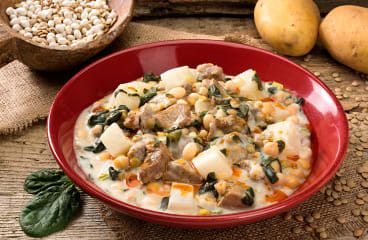Getting Enough Iron
Overview

What is the recommended daily amount of iron?
The recommended daily amount of iron varies. Most people need the following amount of iron each day.footnote 1, footnote 2
Recommended daily amount of iron from foodGroup | Age | Amount of daily iron |
|---|
Adults | Ages 19 and older Ages 19 to 50 (who menstruate) | 8 mg. 18 mg. |
Pregnant | Ages 19 to 50 | 27 mg. |
Lactating (breastfeeding) | Ages 19 to 50 | 9 mg. |
Adolescents | Ages 9 to 13 Ages 14 to 18 | 8 mg. 11 mg. |
Children | Ages 1 to 3 Ages 4 to 8 | 7 mg. 10 mg. |
What foods are high in iron?
The foods you eat contain nutrients, such as vitamins and minerals. Iron is a nutrient. Your body needs the right amount to stay healthy and work as it should. You can use the list below to help you make choices about which foods to eat.
Here are some foods that contain iron. Most have 1 to 2 milligrams of iron per serving. Some have more. footnote 3
Fruits
- Apricots (dried), 1/4 cup (60 mL)
Vegetables
- Asparagus (raw), 6 spears
- Beet, Swiss chard, or turnip greens, 1/2 cup (125 mL)
- Snow or green peas, cooked, ½ cup (125 mL)
- Spinach, (cooked) 1/2 cup (125 mL)
Grains
- Cereals, fortified with iron, 30 g (1 oz)
- Oatmeal, instant, cooked, 3/4 cup (175 mL)
Meats and other protein foods
- Beans (kidney, lima, navy, white), cooked, 3/4 cup (175 mL)
- Beef or lamb, 75 g (2½ oz)
- Chickpeas (garbanzo beans), 3/4 cup (175 mL)
- Liver of beef, chicken, or pork, 75 g (2½ oz)
- Oysters (cooked), 75 g (2½ oz)
- Sardines (canned), 75 g (2½ oz)
- Soybeans (cooked), 3/4 cup (175 mL)
- Tofu (soft, firm, or extra firm), 3/4 cup (150 g)
Work with your doctor to find out how much of this nutrient you need. Depending on your health, you may need more or less of it in your diet.
References
Citations
- Dietitians of Canada (2022). Food sources of iron. Dietitians of Canada. https://www.pennutrition.com/KnowledgePathway.aspx?kpid=403&trid=29347&trcatid=467. Accessed February 14, 2022.
- Unger SL, et al. (2019). Iron requirements in the first 2 years of life. Paediatrics and Child Health, 24(8): 555–556. DOI: 10.1093/pch/pxz148. Accessed October 24, 2022.
- Dietitians of Canada (2022). Food sources of iron. Dietitians of Canada. https://www.pennutrition.com/KnowledgePathway.aspx?kpid=403&trid=29347&trcatid=467. Accessed February 14, 2022.
Credits
Current as of: October 7, 2024
Current as of: October 7, 2024
Dietitians of Canada (2022). Food sources of iron. Dietitians of Canada. https://www.pennutrition.com/KnowledgePathway.aspx?kpid=403&trid=29347&trcatid=467. Accessed February 14, 2022.
Unger SL, et al. (2019). Iron requirements in the first 2 years of life. Paediatrics and Child Health, 24(8): 555–556. DOI: 10.1093/pch/pxz148. Accessed October 24, 2022.
Dietitians of Canada (2022). Food sources of iron. Dietitians of Canada. https://www.pennutrition.com/KnowledgePathway.aspx?kpid=403&trid=29347&trcatid=467. Accessed February 14, 2022.
